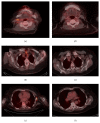Cutaneous Vasculitis: An Unusual Presentation of a Biclonal Nodal Plasma Cell Dyscrasia
- PMID: 29057130
- PMCID: PMC5615981
- DOI: 10.1155/2017/8152610
Cutaneous Vasculitis: An Unusual Presentation of a Biclonal Nodal Plasma Cell Dyscrasia
Abstract
We describe an unusual case of a biclonal nodal plasma cell dyscrasia, presenting with a vasculitic rash, end-organ damage, and cytopenias. Serum protein electrophoresis demonstrated a biclonal kappa-restricted paraprotein, with a negative skeletal survey and no bone marrow disease. Fluorodeoxyglucose-PET-CT (FDG-PET-CT) revealed nodal involvement, which was not appreciable clinically, and facilitated biopsy, confirming the diagnosis of a nodal plasmacytoma. Complete biochemical response and resolution of the vasculitic rash were achieved with bortezomib-based therapy.
Figures


Similar articles
-
POEMS Syndrome with Biclonal Gammopathy: A Rare Association.J Clin Diagn Res. 2017 Jul;11(7):XD12-XD13. doi: 10.7860/JCDR/2017/24800.10265. Epub 2017 Jul 1. J Clin Diagn Res. 2017. PMID: 28893029 Free PMC article.
-
[Efficacy of serum immunoglobulin free light chain and 18F-FDG PET/CT for therapeutic evaluation in a case with multiple plasmacytoma of bone].Rinsho Ketsueki. 2015 Apr;56(4):418-22. doi: 10.11406/rinketsu.56.418. Rinsho Ketsueki. 2015. PMID: 25971273 Japanese.
-
Primary extramedullary plasmacytoma with diffuse lymph node involvement: a case report and review of the literature.J Med Case Rep. 2019 May 22;13(1):153. doi: 10.1186/s13256-019-2087-7. J Med Case Rep. 2019. PMID: 31113466 Free PMC article. Review.
-
A Rare Presentation of Biclonal Gammopathy in Multiple Myeloma with Simultaneous Extramedullary Involvement: A Case Report.Case Rep Oncol. 2019 Jul 16;12(2):537-542. doi: 10.1159/000499902. eCollection 2019 May-Aug. Case Rep Oncol. 2019. PMID: 31427948 Free PMC article.
-
Role of FDG PET-CT in evaluation of locoregional nodal disease for initial staging of breast cancer.World J Clin Oncol. 2014 Dec 10;5(5):982-9. doi: 10.5306/wjco.v5.i5.982. World J Clin Oncol. 2014. PMID: 25493234 Free PMC article. Review.
References
Publication types
LinkOut - more resources
Full Text Sources
Other Literature Sources

